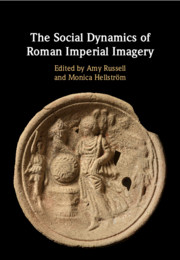Book contents
- The Social Dynamics of Roman Imperial Imagery
- The Social Dynamics of Roman Imperial Imagery
- Copyright page
- Contents
- Figures
- Contributors
- Acknowledgements
- Abbreviations
- 1 Introduction
- 2 The Altars of the Lares Augusti
- 3 Modelling the Emperor
- 4 Publica numina
- 5 Roman Emperors, Conquest, and Violence
- 6 Court Politics and Imperial Imagery in the Roman Principate
- 7 Local Aspirations and Statues of Emperors in Roman North Africa
- 8 The Altar of P. Perelius Hedulus in Carthage and the Social Aspects of Provincial Image-Making
- 9 Imagines et tituli
- 10 The Imperial Image in Media of Mechanical Reproduction
- 11 When Was an Imperial Image?
- Index
- References
9 - Imagines et tituli
Epigraphic Evidence of Imperial Imagery in Meeting Places of Roman Professional corpora
Published online by Cambridge University Press: 09 November 2020
- The Social Dynamics of Roman Imperial Imagery
- The Social Dynamics of Roman Imperial Imagery
- Copyright page
- Contents
- Figures
- Contributors
- Acknowledgements
- Abbreviations
- 1 Introduction
- 2 The Altars of the Lares Augusti
- 3 Modelling the Emperor
- 4 Publica numina
- 5 Roman Emperors, Conquest, and Violence
- 6 Court Politics and Imperial Imagery in the Roman Principate
- 7 Local Aspirations and Statues of Emperors in Roman North Africa
- 8 The Altar of P. Perelius Hedulus in Carthage and the Social Aspects of Provincial Image-Making
- 9 Imagines et tituli
- 10 The Imperial Image in Media of Mechanical Reproduction
- 11 When Was an Imperial Image?
- Index
- References
Summary
This chapter focuses on occupational associations from Rome, Ostia, and other great harbours of the Roman west during the second and the early third century, and explores how these groups, rooted in the middling social categories, used, reacted to, and even created imperial imagery and ideology. Members of these communities met in meeting places where imperial imagery was omnipresent. Imperial imagines were a part of the decorative schemes of places where feasts and rituals celebrated the majesty of the domus Augusta. These objects fostered the politicisation of lower classes, spreading ideological conceptions of the central power and, at the same time, expressed adherence to the imperium. Associations expressed deference towards imperial power with several goals in mind. One part of their motivation was not political or ideological, but social. They aimed to appear to be honourable communities, respected because of their official recognition and their integration into civic life. The wealthiest members encouraged their peers to express loyalty towards imperial power, because political loyalism belonged to a specific habitus expected of candidates for social and civic climbing.
Keywords
- Type
- Chapter
- Information
- The Social Dynamics of Roman Imperial Imagery , pp. 215 - 246Publisher: Cambridge University PressPrint publication year: 2020

